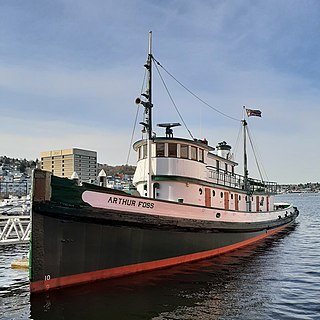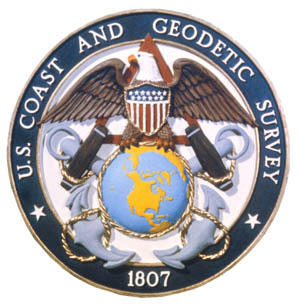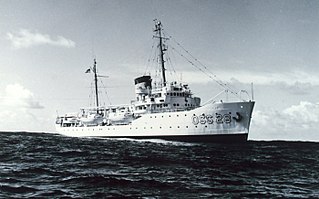
The National Oceanic and Atmospheric Administration Commissioned Officer Corps, known informally as the NOAA Corps, is one of eight federal uniformed services of the United States, and operates under the National Oceanic and Atmospheric Administration (NOAA), a scientific agency overseen by the Department of Commerce. The NOAA Corps is made up of scientifically and technically trained officers. The NOAA Corps and the United States Public Health Service Commissioned Corps are the only U.S. uniformed services that consist only of commissioned officers, with no enlisted or warrant officer ranks. The NOAA Corps' primary mission is to monitor oceanic conditions, support major waterways, and monitor atmospheric conditions.

Arthur Foss, built in 1889 as Wallowa at Portland, Oregon, is likely the oldest wooden tugboat afloat in the world. Its 79-year commercial service life began with towing sailing ships over the Columbia River bar, and ended with hauling bundled log rafts on the Strait of Juan de Fuca in 1968. Northwest Seaport now preserves the tug as a museum ship in Seattle, Washington.

USS Flamingo (AM-32) was a Lapwing-class minesweeper built for the United States Navy near the end of World War I. After service overseas clearing mines after the Armistice, the ship was laid up until 1922 when she was transferred to the United States Department of Commerce for use by the United States Coast and Geodetic Survey. Renamed USC&GS Guide, the ship operated as a survey vessel along the West Coast of the United States for 17 years, making significant contributions to navigation, hydrographic surveying, and oceanography. In June 1941, Guide was transferred back to the Navy, converted into a salvage ship, and renamed USS Viking (ARS-1). As Viking, she worked primarily from bases in California until 1953, when she was sold for scrapping.

USS Oceanographer (AGS-3) was a survey ship of the United States Navy during World War II that produced charts chiefly of passages in the Solomon Islands area of the Pacific Ocean. Upon transfer to the Navy, she had initially briefly been named and classed as gunboat USS Natchez (PG-85). Before her World War II Navy service, she had been USC&GS Oceanographer (OSS-26), a survey ship with the U.S. Coast and Geodetic Survey from 1930.

The steamship Alaskan operated from 1884 to 1889 on the Columbia River and Puget Sound. Alaskan and her near-sistership Olympian were known as "Henry Villard's White Elephants." There were a number of vessels named Alaska and Alaskan, this large side-wheel steamboat should not be confused with them.

The United States Coast and Geodetic Survey, known from 1807 to 1836 as the Survey of the Coast and from 1836 until 1878 as the United States Coast Survey, was the first scientific agency of the United States Government. It existed from 1807 to 1970, and throughout its history was responsible for mapping and charting the coast of the United States, and later the coasts of U.S. territories. In 1871, it gained the additional responsibility of surveying the interior of the United States and geodesy became a more important part of its work, leading to it being renamed the U.S. Coast and Geodetic Survey in 1878.

The MV Tourist No. 2 is a former car ferry with a unique Pacific Northwest history. Tourist No. 2 is a 1924 wooden-hulled car ferry that has served passengers all over the Pacific Northwest. Originally, it took passengers across the Columbia River, with a dock in Astoria, Oregon. Currently, it is undergoing restoration in Astoria. It is listed on the National Register of Historic Places.

NOAAS Discoverer, originally USC&GS Discoverer, was an American Oceanographer-class oceanographic research vessel in service in the United States Coast and Geodetic Survey from 1966 to 1970 and in the National Oceanic and Atmospheric Administration (NOAA) from 1970 to 1996.

USC&GS Patton (ASV-80) was a survey ship that served in the United States Coast and Geodetic Survey from 1941 to 1967.

NOAAS Davidson was a survey ship in commission in the National Oceanic and Atmospheric Administration (NOAA) from 1970 to 1989. Prior to her NOAA service, she was in commission in the United States Coast and Geodetic Survey from 1967 to 1970 as USC&GS Davidson, the second Coast and Geodetic Survey ship of the name. She was the only sister ship of NOAAS McArthur (S 330).

The Ocean ships were a class of sixty cargo ships built in the United States by Todd Shipyards Corporation during the Second World War for the British Ministry of War Transport under contracts let by the British Purchasing Commission. Eighteen were lost to enemy action and eight to accidents; survivors were sold postwar into merchant service.

The first USC&GS Explorer was a steamer that served as a survey ship in the US Coast & Geodetic Survey (USCGS) from 1904-1939 with brief time 1918-1919 assigned to Navy for patrol in Alaskan waters. After initial service in the Atlantic the ship transferred to Seattle in 1907 to begin survey work in Alaskan waters during summer and more southern waters in winter. On return from the Navy the ship was condemned and due to be sold. Instead the ship was retained as a survey vessel into the fall of 1939 and existed into World War II when it saw service with the United States Army Corps of Engineers as Atkins.

The second USC&GS Explorer was a survey ship that served in the United States Coast and Geodetic Survey from 1940 to 1968. She operated in the Pacific Ocean from 1940 to 1960, seeing service there during World War II, and in the Atlantic Ocean from 1960 to 1968.

Rear Admiral Leo Otis Colbert was the third director of the United States Coast and Geodetic Survey and a career officer in the United States Coast and Geodetic Survey Corps, predecessor of the National Oceanic and Atmospheric Administration Commissioned Officer Corps.

USS Helianthus (SP-585) was a patrol vessel in commission in the United States Navy from 1917 to 1919, seeing service in World War I. After her U.S. Navy service, she was in commission in the United States Coast and Geodetic Survey as the survey launch USC&GS Helianthus from 1919 to 1939. She was named after the Helianthus, the genus to which the sunflower belongs.

NOAAS Oregon, previously NOAAS Oregon, was an American fisheries research vessel in commission in the National Oceanic and Atmospheric Administration (NOAA) fleet from 1970 to 1980. Prior to her NOAA career, she operated under the United States Fish and Wildlife Service from 1949 to 1970 as US FWS Oregon.

NOAAS George B. Kelez, previously NOAAS George B. Kelez, was an American research vessel in commission in the National Oceanic and Atmospheric Administration (NOAA) fleet from 1972 to 1980. Prior to her NOAA career, she operated under the United States Fish and Wildlife Service′s Bureau of Commercial Fisheries from 1962 to 1970 as US FWS George B. Kelez and the National Marine Fisheries Service from 1970 to 1972 as NOAAS George B. Kelez.

USFS Eider was an American motor schooner in commission in the fleet of the United States Bureau of Fisheries from 1919 to 1940 and, as US FWS Eider, in the fleet of the U.S. Fish and Wildlife Service from 1940 to 1942 and again in the late 1940s. She ran a passenger-cargo service between Unalaska and the Pribilof Islands, and also carried passengers, supplies, and provisions to destinations on the mainland of the Territory of Alaska and in the Aleutian Islands. She occasionally supported research activities in Alaskan waters and the North Pacific Ocean, and she conducted patrols to protect Alaskan fisheries and marine mammals. In 1924, she provided logistical support to the first aerial circumnavigation of the world.

MV Brown Bear was an American research vessel in commission in the fleet of the United States Department of Agriculture′s Bureau of Biological Survey and Alaska Game Commission from 1934 to 1940 and in the fleet of the United States Department of the Interior′s Fish and Wildlife Service from 1940 to 1942 and from 1946 to 1951, under the control of the University of Washington from 1952 to 1965, and in commission in the fleet of the United States Fish and Wildlife Service from 1965 to 1970 and of the National Oceanic and Atmospheric Administration′s National Marine Fisheries Service (NMFS) from 1970 to 1972.

USFS Pelican was an American fisheries science research ship and fishery patrol vessel that operated along the United States East Coast and the United States Gulf Coast and in the waters of the Territory of Alaska. She was part of the United States Bureau of Fisheries (BOF) fleet from 1930 to 1940. She then served as US FWS Pelican in the fleet of the Fish and Wildlife Service – from 1956 the United States Fish and Wildlife Service – from 1940 to 1958. She served as a fishery patrol vessel while on loan to the Washington Department of Fish and Wildlife from 1958 to 1970, then briefly returned to the Fish and Wildlife Service's successor agency, the National Marine Fisheries Service. Her United States Government service ended when she was sold into private hands in 1972, and she remained extant as of 2010. In 2017 Captain Patrick Burns and Captain John (Johnny) Sylvester purchased the Pelican from Marilyn Masland. She is currently moored in Deer Harbor on Orcas Island, WA. In 2018 she was brought up the Inside Passage to Alaska and back to Washington.






















